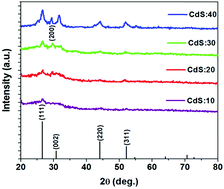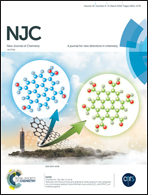Rapid synthesis of CdS nanowire mesh via a simplistic wet chemical route and its NO2 gas sensing properties†
Abstract
In this report, 1-D interconnected CdS nanowires were prepared rapidly via a wet chemical route at relatively low temperature, using cadmium sulphate, thiourea and ammonia as raw materials. The formation of a CdS nanowire mesh (CdS NW mesh) and its structural, optical, surface morphological properties and elemental composition were studied by various characterization techniques. The cubic crystal structure of the CdS interconnected nanowire mesh was confirmed via X-ray diffraction and field emission scanning electron microscopy analysis. The photoluminescence spectroscopy measurements reveal the presence of defects in the as synthesized CdS NW mesh. However, the defect states are beneficial for the gas sensing behavior. Therefore, the gas sensing properties of the CdS NW mesh were studied using NO2 as an analyte gas at moderate operating temperature. The nanowire mesh and inter-wire space were observed to play a crucial role in determining the gas sensing performance of the devices. The as synthesized CdS NW mesh shows a gas response of about 1850% to 100 ppm NO2 gas. In particular, our CdS based gas sensor showed a fifty fold better gas response towards NO2 gas than the earlier reports in the literature. Due to the high value of gas sensitivity, the reported CdS NW mesh could be a suitable candidate for NO2 sensing.



 Please wait while we load your content...
Please wait while we load your content...